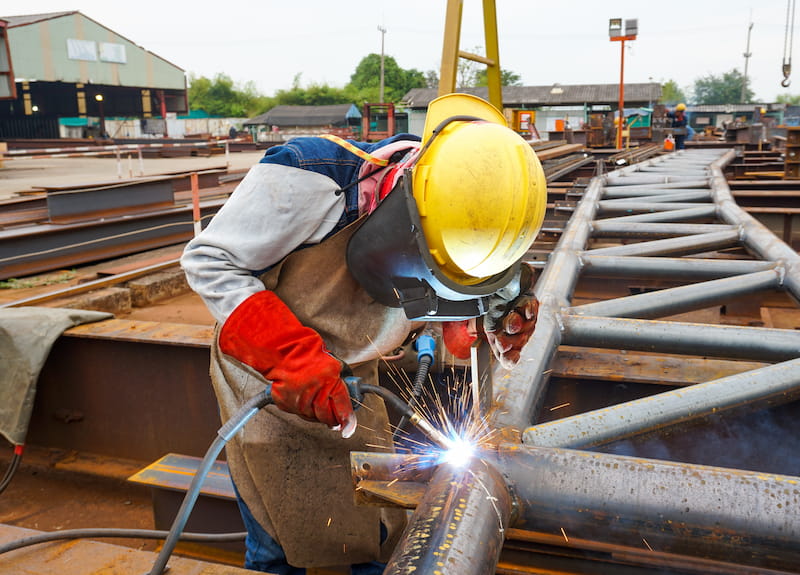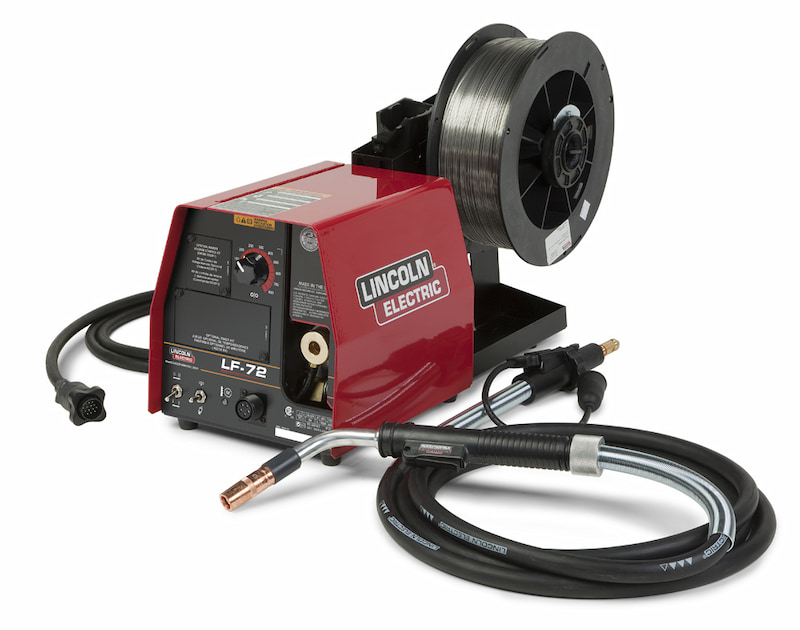Flux-cored arc welding (FCAW) is an automatic or semi-automatic process that uses a consumable tubular electrode in the electric arc to join metals. It was introduced as a solution to overcome the limitations of shielded metal arc welding (SMAW) aka stick welding.
FCAW welding has become an ideal choice for welding ferrous metals. This welding technique is used in shipbuilding, construction, and mechanical industries. Its popularity comes from efficiency and portability compared to other welding processes.
Let’s take a deeper look into this welding technique.
What Is Flux-Cored Arc Welding?
Flux-cored welding is an arc welding process that deposits filler material with a shielding flux in the weld puddle. Fusion takes place when a welding arc is established between the flux-cored electrode and the base metals.
The tubular electrode wire is supplied through a spool and guided by a welding gun to the weld joint. As the electrode melts, the flux inside it releases a shielding gas to protect the weld pool from atmospheric contamination.
Flux-cored welding is often confused with gas metal arc welding (GMAW) as both welding techniques can be performed on the same or similar welding equipment but they do have subtle differences between them.
Differences Between FCAW and GMAW (MIG/MAG)
Generally, flux cored and gas metal arc welding both use the principle of using a shielding layer and a continuous wire-fed electrode.
FCAW welding uses a flux-cored electrode that emits a protective shielding layer as it is deposited into the weld pool. FCAW emits toxic fumes from the flux which blocks the weld area from contaminants. This process is favoured for ferrous metals as it requires little-to-no pre-cleaning.
In some cases, FCAW can use shielding gas on top of the primary shielding flux to further protect the weld pool from oxidation. Dual-shielded FCAW offers more consistent mechanical properties and higher deposition rates than solid wire or stick electrodes.
GMAW (MIG/MAG welding) uses a solid wire electrode along with external shielding gas to prevent contamination of the weld metal. GMAW leaves more weld spatter than FCAW and offers less penetration. MAG and MIG welding offer versatility to weld a wide variety of metals.
GMAW has a bigger electrode wire (2 – 5 mm) compared to FCAW (0.9 – 3.2 mm).
Although these are two separate welding types, the only major difference lies in shielding the weld zone using electrodes and shielding gases.
Flux Cored Welding Process
The FCAW process utilises the heat from the arc generated between the tubular electrode and the workpiece. The electrode is hollow, with a flux core inside acting as a shielding agent while it is deposited in the weld zone. As the flux core is consumed, it produces a barrier protecting the weld from atmospheric contamination.
There are two main options for performing FCAW:
-
FCAW-S (Self-shielded) – Self-shielded welding solely relies on gaseous protection from the flux core and its slag deposits. This process is mostly used for outdoor projects that have unpredictable conditions.
-
FCAW-G (Gas/Dual-shielded) – Dual shield welding uses flux-cored wires along with external shielding gas to provide additional protection for the weld area. This process allows higher deposition rates and offers better penetration against thicker metals.
Certain conditions can also influence the choice for the welding process, such as portability, desired mechanical properties and base metal.
FCAW can be performed semi-automatically wherein a welding professional controls the welding torch, individually adjusting the parameters. It can also be performed fully automatically by implementing robots that can create consistent travel joints.
Flux Cored Arc Welding Variables
To achieve optimum results, the following parameters can be adjusted for every operation:
-
Wire feed speed
-
Contact tip distance
-
Travel speed
-
Polarity
-
Travel and work angle
Electrodes/Wires
There are three main flux-electrode classifications for this welding method:
-
Gas-shielded all position – All position flux cored welding wires are generally smaller than 1/16 inches (~1.6mm) with a fast-freezing flux core. These electrodes are mainly applied to offer more control when welding overhead. As a drawback, these can’t be used with a base metal that has high levels of contamination.
-
Gas-shielded flat position – Flat position welding electrodes are usually greater than 1/16 inches (~1.6mm) and offer fast deposition rates, suited for thicker metals. These are mainly employed for horizontal or flat welding positions and it fares better than all position electrodes against base metal contamination.
-
Self-shielded – These electrodes come in handy for outdoor applications, such as construction or fabrications. They are also perfect for welding galvanised steel or for rare occasions wherein gas cylinders are hard to reach.
Selection of the type of electrode will primarily depend on the following criteria: type of welding current, position, desired mechanical properties, chemical composition and environment.
- Personal account manager
- Quality assurance
- Payment terms for companies
- On-time delivery by Fractory
Materials
While flux-cored arc welding is known for welding ferrous metals, it’s also popular for its versatility when welding the following metals:
-
Stainless steel
-
Low and mild alloy steel
-
Carbon steel
-
Cast iron
-
Hard facing/surfacing alloys
Shielding Gas
Dual shield welding shielding gas comes from cylinders or tanks to the welding torch through a supply hose. These shielding gases protect the weld pool from the atmosphere, reducing the risk of porosity and brittleness. Both inert and active gases may be used as gas shielding elements.
-
Carbon dioxide – FCAW welders prefer using carbon dioxide because of its low cost and deep penetration. Since CO2 is an oxidising gas, deoxidising elements are added to the flux-cored wire to remove the oxygen.
-
Argon and carbon dioxide – A combination of the two gases is sometimes used to generate less spatter. It is usually in the ratio of 75% argon and 25% CO2, with a filler metal resulting in higher strength properties than pure CO2 gas.
-
Argon and oxygen – Pure argon is sometimes mixed with 1-2% oxygen to weld metals that can be corroded with CO2, such as stainless steel. The mixture also promotes less spatter to the weld area, similar to the mixture of argon and CO2.
Welding Gun
-
Air-cooled – Normally, air-cooled guns are sufficient for projects with welding currents less than 500 amperes. The surrounding air is enough to cool down these flux-core guns. Having a shielding gas present further cools down the welding gun. Additionally, air-cooled guns are cheaper and lighter, which makes it easier to manoeuvre and create quality weld beads.
-
Water-cooled – It is recommended to have water-cooled guns for operations requiring a welding current greater than 600 amperes. Typically, it is the preferred choice for continuous flux-cored arc welding operation, where the gun is exposed to high temperatures for longer periods. Water-cooled guns allow water to flow around the nozzle and contact tube to quickly reduce temperatures.
Wire Feeder
The continuously fed tubular electrode is driven by a wire feed motor. The wire feed speed can be configured in this machine to control the delivery from the spool to the welding torch.
Power Source
It is desirable to have a direct current (DC) as the power source for this welding method since it is mostly applied to ferrous materials. DC power supply also creates a more stable arc and offers better penetration.
-
DC positive polarity (DCEP) is the most common power setting since it offers a deep penetration to the weld metal. It is also preferred when using external shielding gas to safely deposit the filler metal to the weld joint.
-
DC negative polarity (DCEN) is utilised for welding thinner metals. While self-shielding flux electrodes can be used with both positive and negative polarities, DCEN is sometimes the choice to achieve a certain result.
Applications of Flux Cored Arc Welding
General Repairs
Some prefer using flux-cored welding in performing general repairs for its portability. It can endure harsh outdoor conditions, at the same time it has the ability to weld ferrous metals.
Pipelines
Due to FCAW welding producing welds with minimal porosity, the pipeline manufacturing industry prefers operating with this technique. With welds created with consistent mechanical properties, pipes have unparalleled strength and durability.
Manufacturing
The manufacturing industry takes advantage of automating the process of flux core arc welding through the use of robots. This results in a precise and consistent welding seam, while all the welding parameters are controlled.
Shipbuilding
The continuously fed tubular electrode allows for an efficient operation in shipbuilding. With the number of minor components to weld together, shipbuilders have to constantly change welding positions. Flux-cored welding works best, as it is easy to perform while shipbuilders manoeuvre the welding torch at varying angles.
Underwater Welding
Divers take advantage of the protection offered by the protective gas layer produced by the flux-cored electrodes. Performing this wet welding procedure requires skill and training as the hazards are beyond comparison to the conditions above ground.
Advantages of Flux Cored Arc Welding
-
FCAW offers higher penetration than MIG/MAG welding.
-
Ability to weld ferrous metals since the electrode deoxidises the base metal.
-
More portable than MIG welding since we can use FCAW without a shielding gas tank.
-
Easier to learn than stick and TIG welding.
-
FCAW and MIG welding use the same machine.
-
The flux creates a shielding layer, allowing it to work well with outdoor welding.
Disadvantages of Flux Cored Arc Welding
-
Slag cleanup.
-
Semi-automatic FCAW results in poorer weld beads than TIG welds.
-
Flux tubular electrodes are more expensive than solid wires.
-
Flux disintegration results in excessive toxic fumes.
-
Trapped gases in the weld zone can form holes as the metal hardens.
-
Changing filler metal is time-consuming since FCAW uses spools compared to some other processes that use short electrodes.
Important Points to Remember
Flux-cored arc welding is a versatile and efficient welding process, making it a better choice for some applications. It’s easier to learn, and the portability that it brings to the table makes it an attractive process.
FCAW is slowly replacing shielded metal arc welding (SMAW) in industries such as manufacturing and construction. The primary reason for that is automation wherein robots are taking over the assembly lines, welding with pin-point accuracy at any welding position.
We can definitely expect flux-cored welding to remain one of the more popular welding methods today, as continuous innovation further improves its efficiency and versatility.





